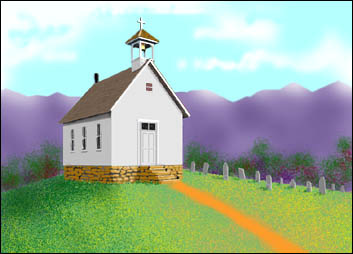
Compiled by Fred Smoot
Major Contributor, tom kunesh

Hilltop Churches and Cemeteries
Churches and their cemeteries our often found on hilltop locations throughout the south. The prime reasons for this are:
1. “Nearer My God To Thee” -- human beings from ancient times have chosen high ground to bury their dead closer to the sky and the gods that live there. Christians who, while having no specific biblical reference for this practice, have adopted it from the previous religious practices of its old converts.
2. Visibility may be a factor since a hilltop locations may provide a better view from the town, and thereby emphasizing the presence of the church. Even the church bell might be better heard from a higher elevation than the town.
3. Hilltops were more difficult to till and thus less promising as farmland than bottomland near rivers and creeks. Since the land for churches was often donated by a land owner, hilltop parcels may have been considered more expendable than fertile farmland.
4. Locating a burial ground anywhere near a high water table is a bad idea: the area could eventually flood. During floods when the soil becomes saturated, the pressure of underground water can cause the caskets -- and the dead - to be forced out of the ground and float down the rivers. New Orleans, which is built close to sea level, dealt problem the problem by using above ground mausoleums. Also, cemeteries built along rivers banks are subject to normal erosion.
5. Generally, rural churches and cemeteries are were built on high ground above the road, and often the cemeteries will be found above the churches - if a difference in elevation was present. Given that cemetery visits are more infrequent than church and town visits, it makes sense to locate a less-visited site in a more secluded area.
Hilltop Family Cemeteries
The family cemeteries, located on the family farms, are often found on un-farmed hilltops. (Close to the house or along the road are also common.) Asides from the “Nearer My God To Thee” explanation and other reasons given above, the hilltop location was a place where the graves would not be disturbed. It is possible that the location was someone’s favorite place, a place for privacy, a place to reflect ...
Recommend Paper:
Cemetery Siting in the Bluestone Reservation Area, Summer County, West Virginia: 1750-1997, by Rebecca K. Cottle, This paper is in Adobe Acrobat Format. You will need to download the file, open it in Acrobat, and then you can print it. A few of its internally linked graphics seem to be non-functioning, but even so, it is well worth it to get a free copy of this remarkable paper on an in depth look at southern burials and customs.



